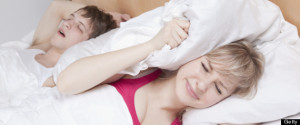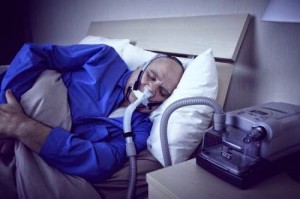Do we need more screening for sleep apnea?
January 30, 2017 | POSTED BY: Michael Joyce is a writer & producer with HealthNewsReview.org
Here we go again. To screen or not to screen, that is the question.
 The U.S. Preventive Services Task Force (USPTF), in a report published in last week’s Journal of the American Medical Association, says there is not enough evidence to weigh the benefits and risks of screening for obstructive sleep apnea (OSA) in adults who don’t have sleep-related symptoms. The USPTF–an independent, volunteer panel of national experts in preventive and evidence-based medicine–points out these results to do not apply to patients with clear symptoms of OSA, or those with conditions that place them at increased risk of developing the sleep disorder.
The U.S. Preventive Services Task Force (USPTF), in a report published in last week’s Journal of the American Medical Association, says there is not enough evidence to weigh the benefits and risks of screening for obstructive sleep apnea (OSA) in adults who don’t have sleep-related symptoms. The USPTF–an independent, volunteer panel of national experts in preventive and evidence-based medicine–points out these results to do not apply to patients with clear symptoms of OSA, or those with conditions that place them at increased risk of developing the sleep disorder.
In response, the American Academy of Sleep Medicine (AASM) reiterated its position that anyone at high risk of developing OSA (“high risk” includes those with obesity, heart failure, irregular heart beat, Type 2 diabetes, asthma, smoking, stroke and treatment-resistant high blood pressure) should be screened even if they don’t have sleep-related symptoms.
Screening for OSA typically involves questionnaires about sleep that often require observations from a bed partner. They are sometimes supplemented with overnight blood oxygen readings from a finger pulse oximeter. Testing to confirm the diagnosis of OSA has typically relied upon polysomnography tests — which record your brain waves, blood oxygen level, heart rate, breathing and leg movements during sleep — although home testing kits are becoming more widely used.
OSA is a potentially serious sleep disorder caused by relaxed throat muscles intermittently blocking the airway leading to periodic and transient cessation of breathing. Classic symptoms include snoring, insomnia, excessive daytime sleepiness, and witnessed gasping or choking at night. If left untreated OSA can lead to a spectrum of mild to-serious consequences including accidents while driving or at work, depression, high blood pressure and–in severe cases–even heart attack, stroke, or sudden death.
Estimates on the prevalence of OSA range from 10 to 20 percent of women being affected and 25 to 35 percent of men (risk for men is approximately double). What is not clear is how many people may have OSA but don’t have symptoms. What’s also not clear is whether screening the general population would reliably pick up this asymptomatic group. Given how common OSA is, the consequences of leaving it untreated, and the uncertainty regarding the scope and ramifications of untreated asymptomatic disease, it’s understandable why screening has become contentious.
News coverage in the wake of the article–and the accompanying editorials–has been basically adequate, though superficial. Other than reporting the USPTF findings, most articles have done what I just did above, that is, clearly list the risk factors, symptoms, and complications of OSA (like this article from HealthDay). However, very few brought up the point that OSA is both under-diagnosed and under-treated and this is, in large part, what forms the basis of the aggressive screening stance of the AASM.
And there is another issue worthy of consideration that I found no mention of … the fact that those who stand to benefit the most financially from screening are often those who advocate the loudest for expanding it.
$leep
 Sleep is big business in this country. The amount Americans spend on drugs and devices to achieve sleep is expected to reach over $80 billion in the next 3 years. The sleep apnea device market alone is a roughly $5 billion dollar industry. But not all the numbers are rosy, especially for sleep clinics which, according to the AASM, peaked at roughly 2,500 accredited centers in 2014. A possible reason for this is the emergence of at-home testing kits that cost around $150 to $250. In contrast, lab-based sleep tests at a typical sleep center usually cost about 3 to 5 times that. A study published this week in the Annals of Internal Medicine found that at-home testing may be as good as laboratory testing in diagnosing OSA. (STAT covered that study, and its implications for the sleep testing market, nicely.) Now fewer insurance companies are covering laboratory-based testing but more are considering covering at-home testing. In short, sleep centers are facing tough times.
Sleep is big business in this country. The amount Americans spend on drugs and devices to achieve sleep is expected to reach over $80 billion in the next 3 years. The sleep apnea device market alone is a roughly $5 billion dollar industry. But not all the numbers are rosy, especially for sleep clinics which, according to the AASM, peaked at roughly 2,500 accredited centers in 2014. A possible reason for this is the emergence of at-home testing kits that cost around $150 to $250. In contrast, lab-based sleep tests at a typical sleep center usually cost about 3 to 5 times that. A study published this week in the Annals of Internal Medicine found that at-home testing may be as good as laboratory testing in diagnosing OSA. (STAT covered that study, and its implications for the sleep testing market, nicely.) Now fewer insurance companies are covering laboratory-based testing but more are considering covering at-home testing. In short, sleep centers are facing tough times.
This is not to say that the AASM (which accredits sleep centers) is not invested in the proper diagnosis and treatment of those with sleep disorders. They are. But it does raise questions: should the financial status of the sleep centers they accredit be taken into consideration when the AASM takes issue with the USPTF findings? And what should we make of their push to screen everyone at increased risk of developing OSA, even if they don’t have sleep-related symptoms?
Screening more people for sleep apnea is not a harmless proposition. Dr. Sachin Pendharkar, a sleep specialist from the University of Calgary, in his editorial accompanying the USPTF study, notes that expanded screening as advocated by the AASM would yield some 27 million false-positive results while finding 13 million cases of sleep apnea.:
“Given that the cost of a single laboratory-based polysomnography test is approximately $782, this would lead to $21 billion in wasted out-of-pocket and system health care costs. Even if all patients who screened positive were tested with a home-based portable monitoring device at a cost of $162 each, the increase in health care costs would be an estimated $4.4 billion. When costs are considered alongside the low diagnostic accuracy of screening tests and the lack of evidence of treatment benefit in asymptomatic patients, the balance tips heavily against screening in the general population.”
A lot of that money would likely end up in the pockets of sleep centers accredited by the AASM.
And what about those millions of false-positives who snowball down a path of diagnosis and treatment that is not only extremely inconvenient (ask someone who uses a CPAP breathing machine at night), but may potentially lead to unforeseen health consequences?
On the other hand, there is something necessary and positive that could come from this yet unresolved debate. First, we in the general public, whether we find ourselves in a patient role or not, could become better observers and reporters of our  sleep habits. Secondly, healthcare providers could commit to becoming better informed and more vigilant regarding sleep disorders; in particular, those in primary care positions who need to make a sleep history automatic in their evaluation of hypertension and depression (two of the major causes of serious health problems and death in medicine). Finally, as both the USPTF and AASM advocate, we need more studies which clarify the long-term outcomes of untreated OSA in those who are asymptomatic, as well as a more evidence-based approach in determining who is at high risk of developing OSA.
sleep habits. Secondly, healthcare providers could commit to becoming better informed and more vigilant regarding sleep disorders; in particular, those in primary care positions who need to make a sleep history automatic in their evaluation of hypertension and depression (two of the major causes of serious health problems and death in medicine). Finally, as both the USPTF and AASM advocate, we need more studies which clarify the long-term outcomes of untreated OSA in those who are asymptomatic, as well as a more evidence-based approach in determining who is at high risk of developing OSA.
These are concrete and feasible actions that we can either sleep on … or act on.
[Editor’s note: This post has been updated to clarify the difference between screening and diagnosis of sleep apnea.]




